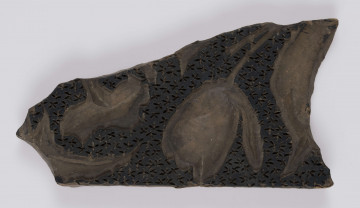
Block for printing on textile
1901 — 1950
National Museum in Lublin
Part of the collection: Fabric printing matrices
One of the ways of decorating textiles that has been known to mankind for centuries was printing patterns on them using stamps. This technique came to Europe from the East. So far researchers have not been able to establish exactly where and when it originated. Over the centuries it has evolved, and the simple blocks used at first have been replaced by special stamps designed for textile printing. They were used in craft workshops in both large centres and small towns as well as by travelling printers who went from village to village offering their services to the local communities. Before the Second World War the presented stamp was in the collection of Pommersches Landesmuseum Stettin. It was made in the woodcarving technique; its maker is unknown. The stamp is densely covered with a pattern consisting of strongly dissected, “winding” wavy lines, which may bring to mind the paths carved by woodworms in trees. The decorations are randomly distributed on the plane. Ethnographer Roman Reinfuss classified this type of stamps, on which the decorative elements are not arranged following a geometric pattern, as blocks with the so-called lost weave repeat. In some regions, they occurred quite often. It can be presumed that the presented matrix was used in one of the small-town dyeing workshops, which were quite numerous in the 19th-century Pomerania.
Author / creator
Dimensions
cały obiekt: height: 6,9 cm, width: 21 cm
Object type
matrix
Creation time / dating
Creation / finding place
Identification number
Location / status

1901 — 1950
National Museum in Lublin

1901 — 1950
National Museum in Lublin

1901 — 1950
National Museum in Lublin
DISCOVER this TOPIC
Castle Museum in Łańcut
DISCOVER this PATH
Educational path